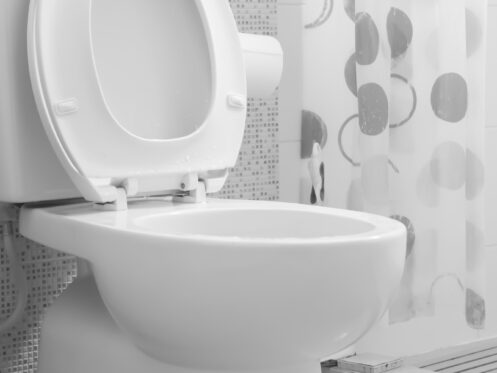Choosing a toilet isn’t just about looks or price. Homeowners may also consider how it’s built, the location of the tank and cistern, how it fits, the functions, and plumbing connection designs that work with their existing setup. Whether you’re tackling a bathroom remodel or just replacing a worn-out fixture, understanding your options helps you pick what works best for your space.
What are the Components of a Toilet?
From a design and classification standpoint, toilets have four main components.
Cistern
The cistern is the section of the toilet that has the seat and the water basin. It is where waste is deposited before a flush. Modern cisterns bring water into the bowl via the rim. Water exits the bowl through the bottom.
Tank
The toilet tank is the location where clean water is stored for a flush. This water is stored in a volume that is large enough to evacuate the toilet contents fully. This is more effective than using a hose or faucet input to remove bodily waste.
Flush Type
The flush indicates the way in which the water is evacuated from the tank. This is classified in a few different ways. The flush mechanism may be a pull chain, lever, push button or automatic sensor. Many toilets evacuate all of the water in the tank when you use the flush mechanism. More modern, dual-flush toilets give you the option to choose between a smaller or larger volume of water from the tank. This can decrease water use in the home.
Plumbing
Each toilet requires plumbing to move water into the tank, from the tank to the cistern and out of the cistern. Toilet categories differ by the length, visibility and location of these pipes.
Common Toilet Classifications
The two most common types of toilets found in American homes are close-coupled and two-piece.
Close-Coupled
A close-coupled toilet has a tank that sits directly on the back of the bowl, forming one compact unit. There is little or no visible gap between the cistern and the bowl. In some cases, this is a single, one-piece unit. This design is common in modern bathrooms because it saves space and looks tidy without additional construction. The flush mechanism usually sits right on top of the tank.
Two-Piece Toilets
Two-piece toilets have more of a gap between the tank and the cistern. These toilets may be sold as two separate components, tank and cistern, designed to fit together. Older, historic two-piece toilets had tanks that would attach to the wall in a high location and a long, visible pipe between the tank and the cistern. Later, the tank was moved above the cistern in a manner similar to close-coupled toilets.
Other Toilet Styles
There are a few additional toilet styles that you may find. These are less commonly used as toilet replacements in residential homes because they often require a professional to create holes in the wall, cover existing holes in the floor and reformat plumbing schemes. However, they may be found in other building types, new homes and remodels.
Wall-hung toilets don’t have a cistern with a base that is attached to the floor. Instead, the cistern is directly attached to the wall with a gap between the bottom of the bowl and the floor. Waste pipes go into the wall. These toilets may not have a visible holding tank. This style of toilet can be customized to be different heights. They are often found in commercial buildings and public restrooms.
Wall-faced or back-to-wall toilets are designed to hide all plumbing from view. They may or may not have a visible tank.
Cleaning Each Type of Toilet
Close-coupled toilets are traditionally easier to clean than two-piece toilets. The tight connection between tank and cistern leaves little to no space between the components. This can save on scrubbing as it reduces the surface area that can be exposed to over-splash or dust. The back is usually smoother and easier to wipe down with a cloth or disinfectant.
Traditional two-piece toilets may have a larger gap that is difficult to reach with cleaning implements but is still exposed to bathroom grime. The layout may provide a cheaper replacement option if you wish to switch out a stained tank or cistern without buying both components again.
Installation Can Vary By Style
Many plumbers charge by the hour for toilet installation. Because of this, ease of installation can save you money when replacing your old model. A close-coupled toilet usually comes as a set with a tank and bowl designed to fit each other perfectly. If your plumbing already matches the setup, the whole thing connects without much adjustment.
A typical two-piece toilet can be just as simple to install. If both components were purchased separately, it may take more time to line up the tank and bowl. Some designs give you a little wiggle room with how the components connect, which comes in handy if your home has older plumbing that doesn’t match newer layouts exactly.
In both cases, hiring a professional to install the toilet can save you headaches. An experienced installer will check the wax ring, floor bolts, and connections to avoid leaks or wobbles.
Style and Bathroom Aesthetics
A close-coupled toilet offers a compact, modern look that fits easily alongside wall-mounted sinks, clean tile lines, or a frameless shower. Close-coupled toilets are one of the most common choices in newer homes and updated bathrooms. Builders often prefer them because they’re easy to install, take up less space, and match modern design trends. You’ll also see them in apartments, guest bathrooms, or anywhere that space is limited. Their neat, one-piece look works well with other compact fixtures, especially in smaller layouts.
On the other hand, a standard two-piece toilet might feel more at home in a bathroom with traditional or vintage touches. If your space invokes a specific decade with a clawfoot tub, paneling or antique-style fixtures, the classic design of a two-piece model may complement that look.
Space Matters More Than You Think
In smaller bathrooms, every inch counts. The distance between the wall and the front of the toilet can affect whether you bump into it when stepping out of the shower or whether you can open a cabinet without hitting the tank. Both close-coupled and two-piece toilets may offer round and oval bowl shapes in the cistern. Additionally, a close-coupled toilet can also provide a slimmer tank profile where the toilet connects to the wall.
Bring Home a New Toilet Today
We serve many different communities in Arizona, California, Colorado, Florida, Nevada and Texas. This includes large metro areas like Phoenix, Houston, Las Vegas and Daytona. We offer expert plumbing services like boiler and water heater installation, leak detection, kitchen and bathroom plumbing and gas line installation and re-piping. Whether you’re ready to install a new bathroom or just replace an old toilet, call Delta Mechanical to get started.


